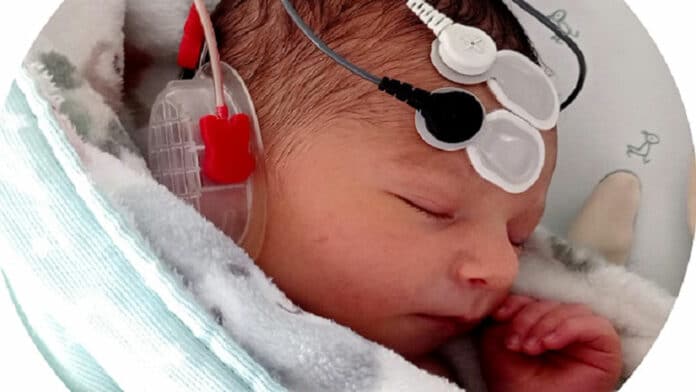Fetal hearing experiences shape the linguistic and musical preferences of neonates. From the first moment after birth, newborns prefer their native language, recognize their mother’s voice, and show greater responsiveness to lullabies presented during pregnancy. Yet, the neural underpinnings of this experience-inducing plasticity have remained elusive.
According to a study led by Professor Carles Escera, head of Brainlab – Research Group on Cognitive Science at the Faculty of Psychology of the University of Barcelona, the Institute of Neurosciences of the UB (UBneuro) and the Sant Joan de Déu Research Institute (IRSJD), when pregnant women sing to their babies or listen to music on loudspeakers during their pregnancy, babies are born with a better ability for neuronal encoding of speech sounds.
The findings suggest that daily musical exposure during the last few weeks of pregnancy is linked to increased low-frequency sound compound encoding, which may enhance the newborn’s perception of tone.
The frequency-following response (FFR), a necrophobic auditory evoked potential that provides information on the appropriate neural coding of speech sounds, is used in this study to examine the impact of prenatal musical exposure on language stimuli. Various speech and language impairments condition the frequency-following response (FFR). It is found to be affected by the fetal environment and the prenatal acoustic environment.
The study is based on the comparison of FFR recordings in 60 healthy newborns (aged between 12 and 72 hours), including 29 who were exposed daily to music during the prenatal period and 31 who were not exposed to music. Specifically, the encephalogram recordings of the babies were analyzed for two different speech stimuli: the /da/ stimulus —the most commonly used in FFR and newborn research— and /oa/, which allows analysis of the frequency coding to which the newborn was exposed in the womb.
As a result, the study’s authors suggest that this measurement might be used as a biomarker to identify the possibility of language impairment and to set up early preventive interventions. AGAUR’s Llavor initiative, the Proof of Concept call for the Fund for the Promotion of Innovation (F2I), managed through the Bosch i Gimpera Foundation (FBG-UB), as well as several other competitive grants for knowledge transfer, have recently been awarded to the research team to validate this concept. These grants were specifically given in the context of the Proof of Concept call given by the Ministry of Science and Innovation.
The doctoral student Sonia Arenillas-Alcón, first author of the article and member of the Brainlab – Cognitive Neuroscience Research Group, said, “Prenatal exposure to music is associated with fine-tuned coding of the fundamental frequency of human speech, which may facilitate processing and early language acquisition. The musical stimulus reaches the auditory system with low-frequency rhythmic components that train it to organize neural plasticity.”
The researchers also discovered that listening to music while pregnant has no impact on the speed of neural transmission, in contrast to adults who have received musical training who process auditory and speech stimuli more quickly due to myelination of the underlying neural structures.
Professor Carles Escera said, “This is only the first step towards a specific clinical application after the necessary follow-up studies. Therefore, children with an attenuated brain response, for example, underweight born babies, could benefit from a musical intervention programme.”
Journal Reference:
- Arenillas-Alcón, S.; Ribas-Prats, T.; Puertollano, M., Mondéjar-Segovia, A.; Gómez-Roig, M.D.; Costa-Faidella, J.; Escera, C. “Prenatal daily musical exposure is associated with the enhanced neural representation of speech fundamental frequency: Evidence from neonatal frequency-following responses”. Developmental Science, December 2022. DOI: 10.1111/desc.13362
